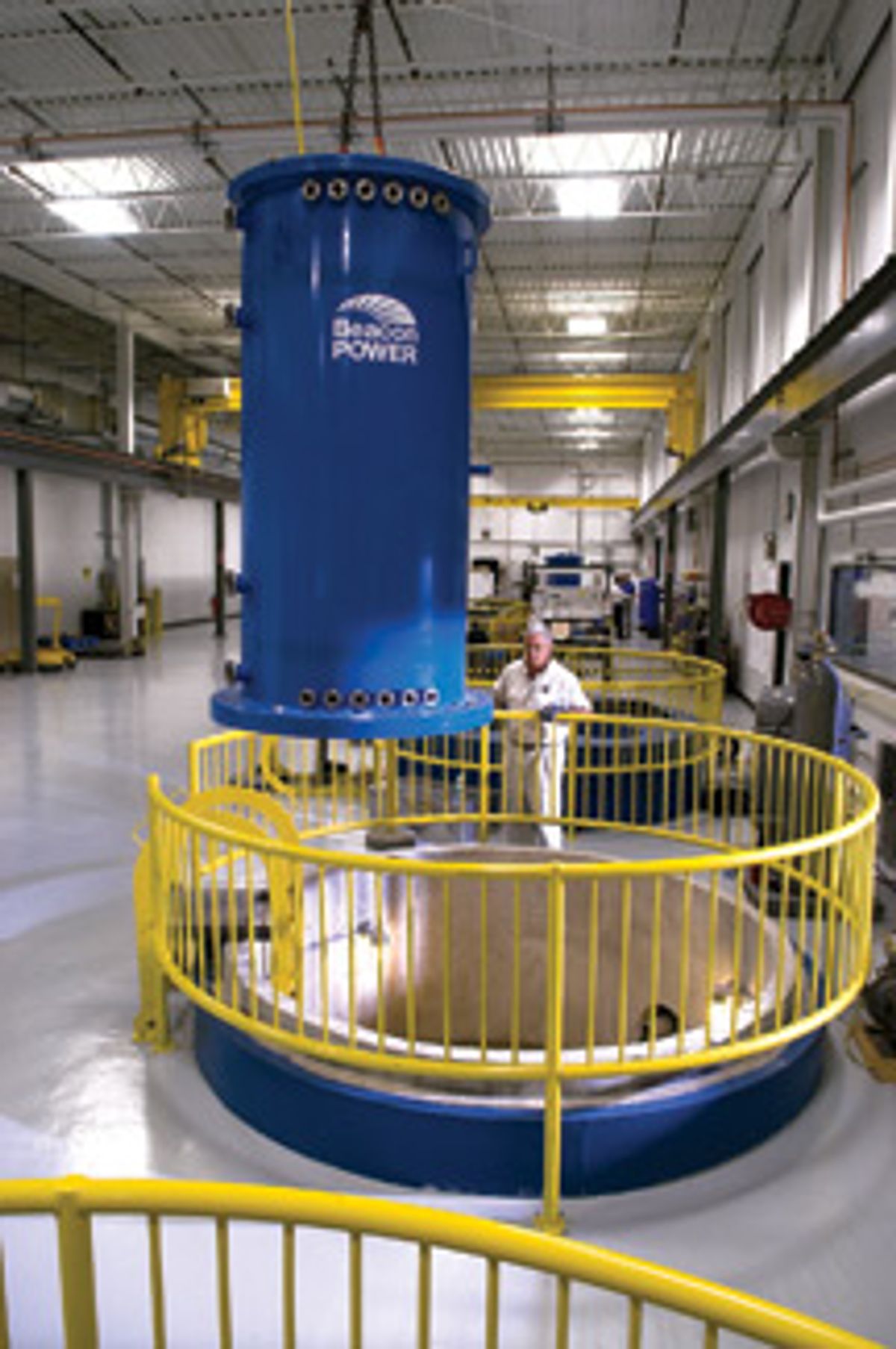Revved Up: A flywheel generator is lowered for high-speed tests.
If you think twirling the mass of a family car hundreds of times a second is an unlikely way to keep power grids humming at perfect pitch, think again. Flywheel developer Beacon Power Corp., based in Tyngsboro, Mass., is already making money that way in Stephentown, N.Y., where it operates more than 160 1150-kilogram magnetically levitated flywheel motor-generators. These machines continuously accelerate and decelerate to balance electrical supply and demand and thus keep New York state's grid tuned to 60 hertz.
AC frequency fluctuates from second to second as generators turn on and off and consumer demand varies. When demand exceeds supply, the extra load slows down power plant turbines, thus depressing frequency. Meanwhile, the turbines accelerate whenever supply is in excess. Frequency regulators add or remove power to restore balance.
Beacon's flywheels can regulate frequency with superior speed relative to the dominant method today—throttling power generators up and down. And grid operators are changing outdated rules to favor faster-acting regulators, including flywheels and grid-scale batteries. The prize: priority access to a frequency regulation market worth US $495 million in the United States last year and growing with the expansion of ever-varying wind and solar power.
The task of frequency regulation has never been a great fit for power plants. Generators operate most efficiently when held steady at high output, so holding capacity in reserve and ramping output up and down increases emissions and fuel costs. And because many power plants take a minute or longer to respond to dispatch signals, much of their contribution is ineffectual or sometimes even counterproductive.
"By the time they get around to responding, things are already going in another direction," explains David Hawkins, a senior principal consultant for the Netherlands-based energy consulting firm Kema, who until last year was lead engineer for integrating renewable energy at California's grid operator.
In contrast, the Stephentown flywheels can switch from full output to full absorption in just a few seconds. Such flexibility means the flywheels can deliver at least twice as much frequency regulation from each megawatt of capacity as a typical natural-gas-fired power plant while cutting carbon emissions in half, according to Hawkins.
Such performance should translate into steady revenues under today's frequency regulation rules—and considerably more as the rules shift. Generally speaking, the independent system operators (ISOs) that manage regional power markets buy frequency regulation services by renting control over tranches of generation capacity. Because they respond more quickly, flywheels are likely to be called upon ahead of power plants. Judith Judson, Beacon's vice president for asset management and market development, says that's been Beacon's experience at Stephentown, which started up in January with 8 megawatts of flywheel capacity and was scheduled to reach its full 20-MW design capacity in June.
Judson says that revenues could triple under an order proposed by the U.S. Federal Energy Regulatory Commission in February that requires ISOs to compensate frequency regulators based on their performance. "If you set aside 20 MW and you're called upon a lot because you can respond fast, you're paid more," says Judson. New England's ISO already has such a "mileage" system under pilot rules, expected to be formalized this year. PJM Interconnection, the grid operator for the mid-Atlantic states, also announced plans for performance pricing, and Beacon is readying a $50 million, 20-MW plant in Hazel Township, Pa., to take advantage of it.
One challenge will be competition from battery-based frequency regulators, which are cheaper per megawatt to install. Several battery systems are testing the market, including a 20-MW frequency regulating facility that Arlington, Va.–based power firm AES is building in Johnson City, N.Y. The $22 million plant uses lithium batteries from A123 Systems.
If facilities such as AES's succeed, frequency regulation could soon be lithium batteries' biggest market. Sanyo Electric, the market leader in lithium-ion battery production, bets that frequency regulation and other grid applications will account for two-fifths of lithium battery sales in 2020. Electric vehicles and consumer electronics will split the rest of the $60 billion market, Sanyo predicts.
Drumroll, Please A carbon-fiber flywheel is removed from a coating chamber.
Beacon, for its part, bets that the apparent cost advantage of batteries will literally erode with time, as constant cycling degrades their capacity. The company says its flywheels in Massachusetts experience the equivalent of 6000 cycles of full charge and discharge or more per year and are designed to withstand that abuse for 20 years, with minimal maintenance or performance degradation.
Kema's Hawkins agrees that batteries will lose their edge over flywheels under that level of use. "A battery really doesn't like to be totally charged and discharged," says Hawkins, "whereas flywheels can handle a pretty severe duty cycle."
But he says that another threat looms, one that could eviscerate the market for frequency regulation: millions of electric vehicles. Plugged in to the grid, they could respond to frequency deviations at the local level.
Pacific Northwest National Laboratory, a unit of the U.S. Department of Energy, proved a similar concept a few years ago, showing that electric water heaters and dryers could correct frequency dips by temporarily turning off their heating elements. In March, PNNL licensed the concept to Texas-based semiconductor start-up Encryptor, which hopes to make chips for appliances.
So in the future, the frequency regulator could be you.


